 This worksheet takes another look at negative numbers and where they are positioned on a number line. This is a good exercise in helping children to count back through zero and then from a negative number forwards, again through zero. Each number line has a different starting and finishing number so care needs to be taken.Try to use the term ‘negative’ rather than ‘minus’ when referring to the numbers.
This worksheet takes another look at negative numbers and where they are positioned on a number line. This is a good exercise in helping children to count back through zero and then from a negative number forwards, again through zero. Each number line has a different starting and finishing number so care needs to be taken.Try to use the term ‘negative’ rather than ‘minus’ when referring to the numbers.
Year 4 Maths worksheet: negative numbers
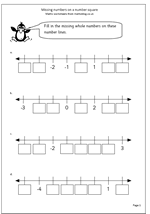 Negative numbers become an important part of maths in Year 4. Usually the best way to teach it is through practical work such as the use of thermometers when the temperature drops below zero. Whilst temperature is read using the term ‘minus’ it is a good idea to read negative numbers as ‘negative 3’ or ‘negative 5’.
Negative numbers become an important part of maths in Year 4. Usually the best way to teach it is through practical work such as the use of thermometers when the temperature drops below zero. Whilst temperature is read using the term ‘minus’ it is a good idea to read negative numbers as ‘negative 3’ or ‘negative 5’.
There are 2 ideas at work here. Firstly, understanding the idea of numbers smaller than zero can be tricky. Children might ask how you can have a number smaller than nothing. An overdraft is always a good starting point to explain this! Also the idea that a larger digit can portray a smaller number eg -6 is smaller than -1.
This maths worksheet uses number lines that go from left to right, from a negative number through zero to positive numbers.
Maths worksheet: Standard short multiplication 1
 This is the standard written method known as ‘short multiplication’. It leads on from the earlier worksheets on ‘Moving towards a standard method’.
This is the standard written method known as ‘short multiplication’. It leads on from the earlier worksheets on ‘Moving towards a standard method’.
Before starting this type of sum a good knowledge of times tables is needed.
The stages are as follows:
Step 1: write the sum out correctly
The question may be put in a different layout eg 38 x 7 =
Make sure it is laid out with the units under each other as shown on the example.
Step 2: multiply the units
Multiply 8 by 7 which 56 or 5 tens and 6 units.
Put the 6 in the answer in the units and place the 5 (tens) in the tens column, under the answer line. Continue reading “Maths worksheet: Standard short multiplication 1”
News: upcoming maths worksheets
 I hope you have all had a good Easter. During the next week we have some great maths worksheets on the standard method of short multiplication, tables, plus paper and pencil methods for division. Also look out for a great negative numbers worksheet, suitable for year 4. We have over 500 pages of free maths resources on the site now – don’t forget to tell your friends!
I hope you have all had a good Easter. During the next week we have some great maths worksheets on the standard method of short multiplication, tables, plus paper and pencil methods for division. Also look out for a great negative numbers worksheet, suitable for year 4. We have over 500 pages of free maths resources on the site now – don’t forget to tell your friends!
Times Table practice: 2, 3, 5 and 10 times tables
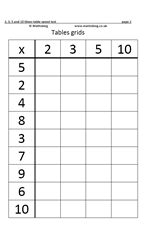 This is the second in a continuing series of times table practice for the 2, 3, 5 and 10 times tables.
This is the second in a continuing series of times table practice for the 2, 3, 5 and 10 times tables.
Any child who knows their tables off by heart is at a huge advantage over those who don’t know them. Many maths problems and techniques, such as long multiplication and division, rely on knowing tables, so it is really worth the effort to learn them. Watch how the grid is filled in as it gives good clues as to what has been learned (which takes no time at all to answer) and what has been ‘worked out’ (which might take a while). Say the table out loud many times – there are songs and recordings that will help.
Year 6 Maths worksheet: Ordering fractions
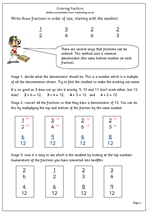 The big question: how do you put fractions in order of size? It is easy to compare fractions if the bottom number (the denominator) is the same for each fraction. 3/12 is smaller than 5/12 etc. But if the denominators are different it becomes more tricky.
The big question: how do you put fractions in order of size? It is easy to compare fractions if the bottom number (the denominator) is the same for each fraction. 3/12 is smaller than 5/12 etc. But if the denominators are different it becomes more tricky.
There are several ways to do this (eg treat each fraction as a division sum and use a calculator to work out the division answers and then order them) but the established method is to change each fraction so that they all have the same denominator.
Warning! If children are going to be successful with this there are several things that they already need to be confident with, including knowing tables and being able to recognise multiples of a number. They also need to know that multiplying the numerator (top) and denominator (bottom) of a fraction by the same number will not change the fractions size – equivalent fractions again! Without this knowledge they will be doomed and confused!!
Let’s take 3/4 and 2/3 as a simple example. To be able to directly compare them the denominators of both fractions need to be the same. Both fractions can be shown in twelfths. (If you don’t understand why I have chosen twelfths then have a look at some of the equivalent fraction pages on the site.)
3/4 can be changed by multiplying 4 by 3 and then 3 by 3 to give 9/12.
2/3 can be changed by multiplying 3 by 4 and 2 by 4 to give 8/12
From this it can be sen that 2/3 or 8/12 is smaller than 3/4 or 9/12.
There is a more detailed explanation on ordering fractions on the maths worksheet pages.
Year 4 maths worksheet: multiplying by 10 and 100
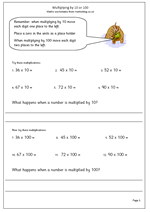 Understanding what happens when you multiply a whole number by 10 is crucial to understanding maths at primary school and indeed with later maths. Children should have carried out lots of practical work with base 10 apparatus in school to show that:
Understanding what happens when you multiply a whole number by 10 is crucial to understanding maths at primary school and indeed with later maths. Children should have carried out lots of practical work with base 10 apparatus in school to show that:
when you multiply a whole number by 10 the digits move one place to the left.
Now this may give the appearance of ‘adding a nought’ as a zero is placed in the units. I know of many teachers and publishers who still use this expression, but it is extremely dangerous, especially when it comes to multiplying decimals by 10. (0.8 is not 0.80).
Multiplying by 100 is the same as multiplying by 10 and then multiplying by 10 again (10 x 10 = 100) so each digit will move two places to the left and zeros will need to be placed in the units and tens.
When you multiply a whole number by 100 the digits move two places to the left.
Maths worksheet: Standard written multiplication 3-digits by 1 digit
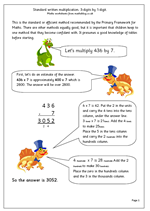 This worksheet uses the standard or efficient method recommended by the Primary Framework for Maths to multiply a 3-digit number by a single digit. There are other methods equally good, but it is important that children keep to one method that they become confident with. It presumes a good knowledge of tables before starting.
This worksheet uses the standard or efficient method recommended by the Primary Framework for Maths to multiply a 3-digit number by a single digit. There are other methods equally good, but it is important that children keep to one method that they become confident with. It presumes a good knowledge of tables before starting.
For example: 436 x 7.
First, do an estimate of the answer.
436 x 7 is approximately 400 x 7 which is 2800. The answer will be over 2800.
Then set the sum out in a vertical layout:
436
x 7
Start with the units.
6 x 7 is 42. Put the 2 in the units and carry the 4 tens into the tens column, under the answer line.
Then multiply the tens.
3 (tens) x 7 is 21(tens). Add the 4 (tens). to make 25(tens).
Place the 5 in the tens column and carry the 2 (hundreds) into the hundreds column.
Finally the hundreds.
4 (hundreds) x 7 is 28 (hundreds). Add the 2 (hundreds) to make 30 (hundreds).
Place the zero in the hundreds column and the 3 in the thousands column.
The answer is 3052.
A clearer layout of this is available on the worksheet explanation.
Further written multiplication worksheets can be found in the Year 5 and Year 6 Calculations sections.
Maths worksheet: Dividing a 2-digit number by a single digit.
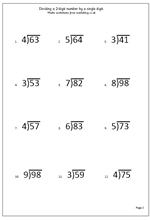 When parents come to help their children with maths it is often division which is the most problematic area. Frequently it is the parents who claim they do not understand the ‘modern methods’ used in school today. The final efficient, or standard method of division is much the same method as it has always been: it is the stages that are used to reach this standard method which cause most confusion. These stages, or steps are aimed at providing children with an understanding of the whole process, although I believe that sometimes they can lead to more confusion.
When parents come to help their children with maths it is often division which is the most problematic area. Frequently it is the parents who claim they do not understand the ‘modern methods’ used in school today. The final efficient, or standard method of division is much the same method as it has always been: it is the stages that are used to reach this standard method which cause most confusion. These stages, or steps are aimed at providing children with an understanding of the whole process, although I believe that sometimes they can lead to more confusion.
Here we have one of these steps towards an efficient method.
77 ÷ 4
4)77
– 40 (10 × 4)
1137
– 36 ( 9 × 4)
0111
Next, take away a tens multiple of the divisor (4). 10 x 4 = 40.
Subtract 40 from the 77 leaves 37.
Then ask, ‘How many 4s in 37?’
9 x 4 is 36 so it is 9 with a remainder of 1.
Add the 10 and the 9 which makes 19.
Answer: 19 remainder 1.
All these questions have a single tens multiple of the divisor. Of course, this will not always be the case as questions become harder.
Division: 2 digit by 1 digit (pg 1)
Year 5 Maths Worksheet: Multiplying a 3-digit number
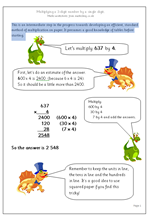 This is an intermediate step in the progress towards developing an efficient, standard method of multiplication on paper. It presumes a good knowledge of times tables before starting.
This is an intermediate step in the progress towards developing an efficient, standard method of multiplication on paper. It presumes a good knowledge of times tables before starting.
An important part of this process which is often neglected, is that an estimate of the answer should be quickly worked out ‘in your head’ before beginning the written answer. This can be done by quickly rounding the numbers.
For example: 637 x4 is round about 2400.
This intermediate process does the sum 637 x 4 in four parts:
1. Multiply the hundreds 600 x 4
2.Multiply the tens 30 x 4
3. Multiply the units 7 x 4
4. Add the 3 answers.
The first three stages can be reversed, multiplying the units first.